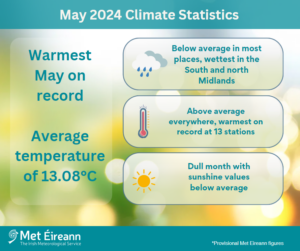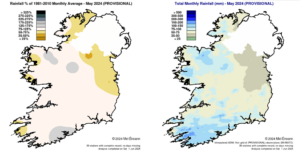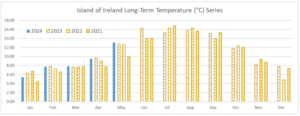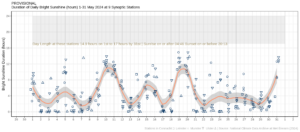Warmest May on record. Calm, dull and thundery at times
- Overall (using the Island of Ireland dataset*), May 2024 was the warmest May on record with an average temperature of 13.08 °C, which is 2.53°C above the 1961-1990 long term average (LTA) or 1.74 °C above the 1991-2020 LTA for May.
- This is only the 2nd time (in 125), that the May average temperature exceeded 13 °C. The previous warmest May was May 2008 with an average monthly temperature of 13.03 °C. The coldest May remains May 1923 (102 years ago) with an average temperature of 8.67 °C.

April 2024 Climate Statistics
May 2024 was very mild but also quite dull overall. Weak steering currents aloft brought a mixture of slow-moving areas of high and low pressure over the country in a mostly slack airflow. Rainfall totals were mixed with a few active weather fronts and some intense thundery downpours giving higher totals in the South and parts of the Midlands while the East and Northwest had a relatively dry month. The month began with low pressure meandering close to or over Ireland bringing bands of rain or showers at times as a warm and moist airmass moved in from the east and became established over the country. It was mostly dry between Saturday 4th and Saturday 11th as high pressure gradually built over Ireland, which culminated in two warm and sunny days on Friday 10th and Saturday 11th. Thunderstorms broke out in the East on Sunday 12th before widespread frontal rain crossed the country on Monday 13th as low pressure moved close to the south coast. Most of the rain that fell between Tuesday 14th and Friday 24th was convective in nature and came in the form of thundery downpours. Some places got a lot of rain in short intense bursts, especially the South and parts of the Midlands, while other places stayed mostly dry with sunny spells at times. Further frontal rain crossed the country on Saturday 25th and Sunday 26th as low pressure approached from the west. The month finished showery as low pressure pulled away and high pressure built from the west.
Rainfall: Below average in most places, wettest in the South and north Midlands
The majority of monthly rainfall totals across the country were below their 1981-2010 Long-Term Average (LTA). Percentage of monthly rainfall values ranged from 48% (monthly rainfall total of 32.4 mm) at Ballyhaise, Co Cavan to 151% (monthly rainfall total of 106.5 mm) at Mount Dillon, Co Roscommon. Monthly rainfall totals ranged from 29.3 mm (50% of its LTA) at Casement Aerodrome, Co Dublin to 124.7 mm (136% of its LTA) at Knock Airport, Co Mayo. The month’s wettest day was also recorded at Knock Airport, Co Mayo with 34.9 mm on Sunday 26th (its highest daily rainfall in May since 2005). The number of rain days* ranged from 11 days at Mace Head, Co Galway to 18 days at Mullingar, Co Westmeath. The number of wet days* ranged from 7 days at Dunsany, Co Meath to 13 days at a few stations. The number of very wet days* ranged from zero days at Phoenix Park, Co Dublin to 5 days at both Roche’s Point, Co Cork and Cork Airport.

Rainfall % of 1981 – 2010 Monthly Average for May 2024 (Provisional) Total Monthly Rainfall (mm) for May 2024 (Provisional)
Temperature: Above average everywhere, warmest on record at 13 stations
- Warmest May on record at thirteen synoptic stations including Phoenix Park, Co Dublin and Malin Head, Co Donegal which have record lengths of 125 years.
- Three stations had their highest mean maximum temperature for May on record.
- Fourteen stations had their highest mean minimum for May on record.
- There were no air frosts reported for the third consecutive May
All mean air temperatures across the country were above their LTA for the month. Deviations from mean air temperature for the month ranged from 1.1 °C (12.7 °C mean temperature) at Mace Head, Co Galway to 2.9 °C (13.6 °C the month’s highest mean temperature) at Phoenix Park, Co Dublin (its warmest May on record (record length 125 years)). Mean temperatures for the month were lowest at Knock Airport, Co Mayo with 11.8 °C (1.8 °C above its LTA). The month’s lowest temperatures were recorded on Sunday 5th with the lowest air minimum reported at Moore Park, Co Cork with a temperature of 2.6 °C and the lowest grass minimum reported at Oak Park, Co Carlow with -1.7 °C. The highest maximum was reported on Monday 20th at Mount Dillon, Co Roscommon with a temperature of 24.6 °C. There was no air frost reported this month. Less than half of stations reported ground frost. The number of days with ground frost ranged from zero days at most stations to 2 days at both Ballyhaise, Co Cavan and Mount Dillon, Co Roscommon. Thirteen stations, including Phoenix Park, had their warmest May on record (record lengths 17- 125 years). These were Oak Park, Co Carlow with a mean temperature of 13.3 °C (2.3 °C above its LTA), Dublin Airport with 13.0 °C (2.3 °C above its LTA), Ballyhaise, Co Cavan with 13.1 °C (2.1 °C above its LTA), Mullingar, Co Westmeath with 13.0 °C (2.5 °C above its LTA), Roches Point, Co Cork with 13.0 °C (1.6 °C above its LTA), Dunsany, Co Meath with 13.2 °C (2.8 °C above its LTA), Gurteen, Co Tipperary with 12.7 °C (1.9 °C above its LTA), Malin Head, Co Donegal with 12.2 °C (1.8 °C above its LTA), Athenry, Co Galway with 12.7 °C (1.4 °C above its LTA), Mount Dillon, Co Roscommon with 13.1 °C (2.2 °C above its LTA), Finner, Co Donegal with 12.8 °C (1.9 °C above its LTA) and Casement Aerodrome, Co Dublin with 13.4 °C (2.6 °C above its LTA). Three other stations in the Northwest had their warmest May since 2008. Three stations had their highest mean maximum temperature for May on record and fourteen stations had their highest mean minimum for May on record. This indicates that night-time temperatures were particularly high during May 2024, which helped to increase the overall mean temperatures.

Average Monthly Temperatures (using the Island of Ireland dataset*) for 2021, 2022, 2023 and 2024 so far. June, July, August and September are on average the warmest months of the year.
Sunshine: Dull overall
All available monthly sunshine totals were below their LTA. Percentage of monthly sunshine values ranged from 79% (monthly sunshine total of 142.8 hours) at Shannon Airport, Co Clare (its dullest May since 2014) to 80% (monthly sunshine total of 148.6 hours) at Casement Aerodrome, Co Dublin (its dullest May since 2014). Monthly sunshine totals ranged from 121.8 hours (No LTA comparison*) at Gurteen, Co Tipperary to 161.1 hours (No LTA comparison*) at Valentia Observatory, Co Kerry. The highest number of daily sunshine hours recorded this month was 14.9 hours at both Johnstown Castle, Co Wexford on Sunday 19th and Cork Airport on Monday 20th. The number of dull days* ranged from 3 day at both Johnstown Castle, Co Wexford and Valentia Observatory, Co Kerry to 10 day at Gurteen, Co Tipperary.

Hours of Bright Sunshine observed at nine stations for each day of the month of May 2024, grouped by province relative to the highest number of hours possible by end of month (shaded box)
Wind: Not significantly strong
Monthly mean wind speeds ranged from 4.9 knots (9.1 km/h) at Ballyhaise, Co Cavan to 10.4 knots (19.3 km/h) at Malin Head, Co Donegal. There were no days with gales, strong gales or storms reported this month. Both the month’s highest gust and 10-minute mean wind speed was reported at Malin Head, Co Donegal. The highest gust was on both Wednesday 22nd and Thursday 23rd with 39 knots (72 km/h) while the month’s highest 10-minute mean wind speed was 32 knots (59 km/h) on Thursday 23rd.
The full report is available at https://www.met.ie/climate/past-weather-statements

May 2024 extreme values at synoptic stations
*Issued by Met Éireann on Thursday 2nd May 2024. This report is based on available preliminary data from 25 principal weather stations operated by Met Éireann. Synoptic station data is midnight to midnight UTC. Long-Term Averages (LTAs) and “average” refer to the period 1981-2010 unless stated. A rain day is a day on which 0.2 mm or more of rainfall is measured. A wet day is a day with 1.0 mm or more of rainfall. A dull day is a day with less than 0.5 hours of sunshine. A very wet day is a day with 10.0 mm or more of rainfall. Climatological dry periods – An absolute drought is a period of 15 or more consecutive days to none of which is credited 0.2 mm or more of precipitation. A partial drought is a period of at least 29 consecutive days, the mean daily rainfall of which does not exceed 0.2 mm. A dry spell is a period of 15 or more consecutive days to none of which is credited 1.0 mm or more of precipitation (i.e. daily tot < 1.0 mm). A heatwave occurs where there are 5 consecutive days or more with maximum temperature over 25°C (that is, a daily maximum screen air temperature > 25° C). The Island of Ireland dataset is 125 years long and runs between 1900 and 2023. For this dataset the long term averages from the 1961-1990 reference period are used for comparison as is standard for long-term climate change assessments. *Sunshine data is from the Autosol Network. LTAs for these sites are currently not used for comparison purposes. For more information, contact Met Éireann at 01-8064200 or e-mail: enq@met.ie